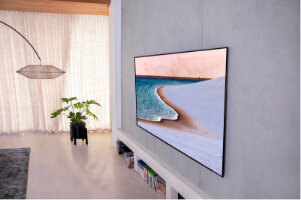Backlighting - Why is it important?
Posted on 12:00am on Wednesday 22nd February 2017 by Walts Why is backlight important? Backlight (or Edge lighting) is necessary for all LCD TVs. Without it you wouldn’t be able to see the picture.
Local dimming was developed to improve this aspect of LED LCD performance. By dimming the parts of the screen that should be dark and keeping bright the parts of the screen that should be bright, you can improve the apparent contrast ratio. As LCD technology has advanced, local dimming has as well. As the LCD industry moved towards the cheaper, thinner edge-lighting methods, local dimming was adapted to work with these TVs too.
Full-array local dimming is the Ultimate. The name refers to an array of individual LEDs behind the LCD panel, all pointing out through the screen toward your eyeballs. Individual control of all these LEDs would be ideal (though rarely implemented), the most common method is a set number of "zones." Depending on the TV, these could number in the dozens or more. Unfortunately, most LED TV makers don't disclose the number. Each zone is responsible for a certain area of the screen.
An offshoot of full-array local dimming, direct local dimming simply means fewer LEDs. They're still arranged behind the screen, but there are fewer of them, and not as many dimmable zones Objects smaller than the zone don't benefit from the local dimming, and can look muted as a result. Also, if a zone is lit, and an adjacent zone isn't lit, you could see a halo/bloom as that part of the screen becomes brighter than its neighboring zone. This artifact is commonly known as "blooming."
Edge-lit local dimming is local dimming on edge-lit LED LCDs. With edge-lit LCDs, all the LEDs are along the edge of the TV, facing the center of the screen. Depending on where the LEDs are (along all four sides of the screen, just the right and left, just the top and bottom, or just the bottom or the top), edge-lit local dimming can have widely different performance.
Global dimming One last trick isn't really "local" dimming as much as it's just "dimming”. The entire image will get darker with dark scenes, and stay bright with bright scenes. On many models when given a full black image (like the fade-out at the end of a movie, but before the credits start) the LEDs will shut off completely, making it seem like the TV has a really good black level. Another variation of the theme senses the average brightness of the scene and, during darker scenes, ratchets down the whole backlight. Again black levels improve at the expense of highlights and sometimes-visible fluctuations in overall brightness.
Back lit led vs edge lit.
LED LCDs don't have the contrast ratio potential of Plasma and OLED TVs.Local dimming was developed to improve this aspect of LED LCD performance. By dimming the parts of the screen that should be dark and keeping bright the parts of the screen that should be bright, you can improve the apparent contrast ratio. As LCD technology has advanced, local dimming has as well. As the LCD industry moved towards the cheaper, thinner edge-lighting methods, local dimming was adapted to work with these TVs too.
Full-array local dimming is the Ultimate. The name refers to an array of individual LEDs behind the LCD panel, all pointing out through the screen toward your eyeballs. Individual control of all these LEDs would be ideal (though rarely implemented), the most common method is a set number of "zones." Depending on the TV, these could number in the dozens or more. Unfortunately, most LED TV makers don't disclose the number. Each zone is responsible for a certain area of the screen.
An offshoot of full-array local dimming, direct local dimming simply means fewer LEDs. They're still arranged behind the screen, but there are fewer of them, and not as many dimmable zones Objects smaller than the zone don't benefit from the local dimming, and can look muted as a result. Also, if a zone is lit, and an adjacent zone isn't lit, you could see a halo/bloom as that part of the screen becomes brighter than its neighboring zone. This artifact is commonly known as "blooming."
Edge-lit local dimming is local dimming on edge-lit LED LCDs. With edge-lit LCDs, all the LEDs are along the edge of the TV, facing the center of the screen. Depending on where the LEDs are (along all four sides of the screen, just the right and left, just the top and bottom, or just the bottom or the top), edge-lit local dimming can have widely different performance.
Global dimming One last trick isn't really "local" dimming as much as it's just "dimming”. The entire image will get darker with dark scenes, and stay bright with bright scenes. On many models when given a full black image (like the fade-out at the end of a movie, but before the credits start) the LEDs will shut off completely, making it seem like the TV has a really good black level. Another variation of the theme senses the average brightness of the scene and, during darker scenes, ratchets down the whole backlight. Again black levels improve at the expense of highlights and sometimes-visible fluctuations in overall brightness.





